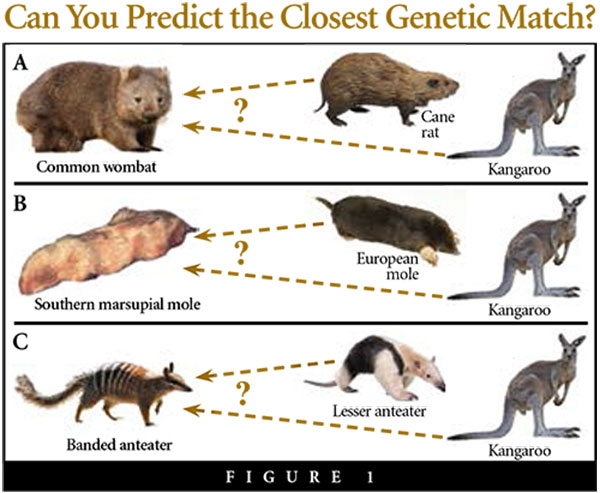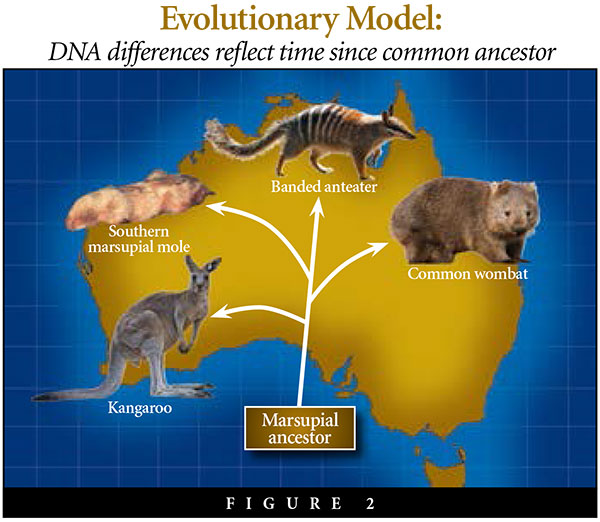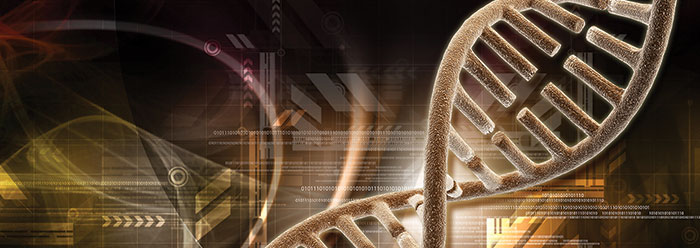Which creature would you expect to be genetically closer to a common wombat—a cane rat or a kangaroo (Figure 1A)? What about a southern marsupial mole? Would you expect it to be more genetically related to other moles or to kangaroos (Figure 1B)? Would you predict banded anteaters to be genetically closer to other types of anteaters or to kangaroos (Figure 1C)? Since genetics is the blueprint for a creature’s form and function, you might intuitively suppose that creatures that are outwardly similar are also genetically similar.
 Surprisingly, this seemingly uncontroversial expectation is implicitly based on a creationist origins position. Evolutionists propose a substantially different origin for these creatures than creationists do, and the actual genetic differences among these creatures reveal one of the strongest arguments for evolution and one of the most challenging puzzles for creation to date.
Surprisingly, this seemingly uncontroversial expectation is implicitly based on a creationist origins position. Evolutionists propose a substantially different origin for these creatures than creationists do, and the actual genetic differences among these creatures reveal one of the strongest arguments for evolution and one of the most challenging puzzles for creation to date.
The evolutionary predictions for genetic similarity among these creatures derive from the evolutionary understanding of both the fossil record and of continental drift. The southern mole, the common wombat, the banded anteater, and the kangaroo are all classified as marsupials, and according to the dates that evolutionists assign to the marsupial fossil record, their ancestors existed in North America about 80 million years ago. The descendants of these creatures moved down through South America and across Antarctica around 35 million years ago, when the latter two continents were still connected, and finally crossed over to Australia about 10 million years ago when Australia and Antarctica were still linked. Since their arrival, these marsupial ancestors supposedly evolved into today’s wombats, marsupial moles, banded anteaters, kangaroos, and all other marsupial species that exist in Australia today (Figure 2).1
 In light of this version of history, evolutionists expect Australian marsupial species to be genetically closer to one another than to any other species on Earth. The biological basis for this view is straightforward. At conception, when sperm meets egg, each cell contributes a copy of its DNA to the new life, but the process of transmission happens imperfectly, and consequently, genetic errors occur. Thus, each generation grows more genetically distant from previous generations as each new fertilization event contributes more genetic mistakes to the lineage. Therefore, if two individuals share a recent common ancestor, they will possess fewer genetic differences.
In light of this version of history, evolutionists expect Australian marsupial species to be genetically closer to one another than to any other species on Earth. The biological basis for this view is straightforward. At conception, when sperm meets egg, each cell contributes a copy of its DNA to the new life, but the process of transmission happens imperfectly, and consequently, genetic errors occur. Thus, each generation grows more genetically distant from previous generations as each new fertilization event contributes more genetic mistakes to the lineage. Therefore, if two individuals share a recent common ancestor, they will possess fewer genetic differences.
Since evolutionists postulate that marsupials share their nearest kinship with other marsupials, they expect genetics to clearly reflect this ancestry. For example, they would predict wombats to be genetically closer to kangaroos and marsupial moles than to cane rats or any other rodents. They would also anticipate a closer genetic relationship between banded anteaters and kangaroos than between banded anteaters and non-marsupial anteaters.
The actual genetic similarities among these creatures match these evolutionary expectations. Though the entire DNA sequence for each creature has not yet been elucidated, the DNA sequences that have been obtained—those that encode mitochondrial proteins—and the protein sequences derived from these DNA sequences demonstrate a close genetic match among these marsupials and a distant genetic match between the marsupial species and their non-marsupial counterparts. For example, for the mitochondrial energy protein termed ND6, wombats are 80 percent identical to kangaroos but only 38 percent identical to cane rats. Marsupial moles are 68 percent identical to kangaroos but only 45 percent identical to other moles. Banded anteaters show a similar pattern—82 percent identity with kangaroos but only 52 percent with other anteaters.
How would you, as a creationist, respond to these data that appear to support the evolutionary model? You might be tempted to invoke a functional explanation for the similarities. Perhaps wombats and kangaroos are similar at the protein level because the sequences that were compared between these two species play a role in marsupial physiology.
The problem with this hypothesis is that these protein sequences perform the same task in each of these creatures—energy transformation inside the cell. Conventional molecular biology wisdom sees no reason for these proteins to have different sequences if they perform exactly the same function. It’s like comparing the light switches used in a house, a barn, a factory, and an office; there is no reason to reinvent the basic design if the switch functions the same way in each location.
In view of these facts, you might propose a different hypothesis. Creatures are not inanimate light switches; species change over time in a heritable manner. Perhaps God supplied all of these creatures with the same DNA and protein sequences at creation, and since then each of these creatures might have randomly mutated at different rates. This process would produce a hierarchy of sequence differences, perhaps quite similar to the ones we actually observe.
How might you test this hypothesis? The history recorded in Genesis puts very clear constraints on the genealogy and genetic history of each modern species. Given this history, perhaps you could predict which genetic patterns are possible and identify the best explanation by process of elimination.
I employed this method to find the underlying reason for the genetic patterns among species like the marsupials we discussed above. I carefully derived a mathematical model to test the hypothesis of random change over time from an identical starting sequence. This model predicts that if two species were created with identical DNA sequences and if they both randomly mutated/changed over time after creation, then these two species should continually have grown more genetically distant, not closer.
However, comparing the protein sequences across thousands of animal species revealed thousands of deviations from this prediction.
How would you respond to this unsettling discovery? What other hypotheses could you invoke? Does the creation model have any plausible explanation left?
This negative result was actually the first step toward discovering new insights into DNA function, and it turned the tables on the evolutionary argument. By eliminating the hypothesis of functionally neutral change over time, I was able to clearly identify the hole in modern molecular biology thinking. Though each protein has historically been thought to perform a single function inside the cell—like energy transformation—these negative results required a modification to this rule. Combined with preliminary data from the secular literature, these results suggest that each protein might perform several functions. For example, proteins involved in energy transformation in fish might also play a role in fin formation and underwater respiration. It’s as if a light switch were designed not only to control electricity but also to simultaneously support the ventilation system, maintain the foundation, and repair the roof.
Hypothesizing multi-functional proteins stretches the imagination and even seems to strain credulity. But the Master Designer has no such intelligence limitations, and He appears to have designed numerous proteins for multiple purposes.2
These conclusions were strengthened when these same protein comparisons across thousands of species showed a strong correlation with traditional classification rank and category. Since these rankings are based on each group’s functional characteristics—anatomy, physiology, and development—this correlation provides further evidence for a multi-functional role for these protein sequences. Together, these results suggest that God created mitochondrial protein sequences unique to each “kind” for hitherto unanticipated biological purposes.3
Practically, this finding reveals new insights into the puzzle of protein similarity among marsupials. At first pass, the high similarity among marsupials and the low similarity between marsupials and their non-marsupial counterparts appear to reflect evolution, but these same data can be explained equally well by multi-functional design. It seems that these mitochondrial energy proteins function not only in energy transformation but also in some aspect of marsupial physiology or development.
If both creation and evolution explain the same data equally well, which one is correct? In the future, both of these explanations can be tested head-to-head in the laboratory since each makes very different predictions. According to evolution, modern genetic differences among marsupials and non-marsupials reflect functionally neutral changes since these species last shared a common ancestor—they do not reflect some higher-order design paradigm. In contrast, our creation model suggests that the genetic differences primarily reflect differences in multi-level function. The hypotheses of multi-function and single function are both amenable to experimental verification.
In summary, I—with help from other members of ICR’s BioOrigins team—have discovered a new answer to one of the most perplexing evolutionary challenges to date.4 Protein similarities and differences among diverse species seem, at first glance, to support Darwin’s “tree of life.” But our team’s results reveal that this inference is based on faulty ideas about how each protein actually functions.
The findings discussed in this article apply mainly to comparisons of one kind of creature to another kind. Genetic differences also exist within a kind—for example, among the cats that descended from a common ancestor on board the Ark and among the equids (donkeys, zebras, horses) that descended from their common Ark ancestor.5 In a future issue we’ll tell you about a startling discovery we made when comparing genetic similarity among members of the same kind.
References
- Coyne, J. 2009. Why Evolution Is True. New York: Penguin Group.
- Jeffery, C. J. 2003. Moonlighting proteins: old proteins learning new tricks. Trends in Genetics. 19 (8): 415-417.
- Jeanson, N. 2013. Recent, Functionally Diverse Origin for Mitochondrial Genes from ~2700 Metazoan Species. Answers Research Journal. 6: 467-501.
- The BioOrigins team also includes Jeff Tomkins, Frank Sherwin, and Brian Thomas.
- Jeanson, N. 2013. Is Evolution an Observable Fact? Acts & Facts. 42 (1): 20.
* Dr. Jeanson is Deputy Director for Life Sciences Research at the Institute for Creation Research and received his Ph.D. in cell and developmental biology from Harvard University.

















